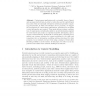MOBIDE
2003
ACM
14 years 5 months ago
2003
ACM
The common vision of pervasive computing environments requires a very large range of devices and software components to interoperate seamlessly. From the assumption that these dev...
ICDCSW
2003
IEEE
14 years 5 months ago
2003
IEEE
Pervasive computing environments are characterized by an additional heterogeneity compared to existing computing infrastructures. Devices ranging from small embedded systems to fu...
MIDDLEWARE
2004
Springer
14 years 5 months ago
2004
Springer
In pervasive computing environments, conditions are highly variable and resources are limited. In order to meet the needs of applications, systems must adapt dynamically to changi...
SPC
2005
Springer
14 years 5 months ago
2005
Springer
In pervasive computing environments, changes in context may trigger changes in an individual’s access permissions. We contend that existing access control frameworks do not provi...
SPC
2005
Springer
14 years 5 months ago
2005
Springer
Alice first meets Bob in an entertainment shop, then, they wish to share multimedia content, but Do they know what are trustworthy users? How do they share such information in a s...
PERVASIVE
2005
Springer
14 years 5 months ago
2005
Springer
Pervasive computing environments will combine everyday physical spaces with network aware devices and services; hence providing computing behaviour that is much more entwined with...
OTM
2005
Springer
14 years 5 months ago
2005
Springer
Timeliness in conventional real-time systems is addressed by employing well-known scheduling techniques that guarantee the execution of a number of tasks within certain deadlines. ...
OTM
2005
Springer
14 years 5 months ago
2005
Springer
Context-aware applications rely on implicit forms of input, such as sensor-derived data, in order to reduce the need for explicit input from users. They are especially relevant for...
CAISE
2005
Springer
14 years 5 months ago
2005
Springer
Abstract. Dynamic Aspect-Oriented Programming (d-AOP) is an important tool to implement adaptation in a wide variety of applications. In particular, large distributed infrastructur...
IPPS
2005
IEEE
14 years 5 months ago
2005
IEEE
An efficient addressing scheme is necessary for auto-configuration and seamless communication in pervasive computing environments. In this paper, we propose an efficient and simple...



